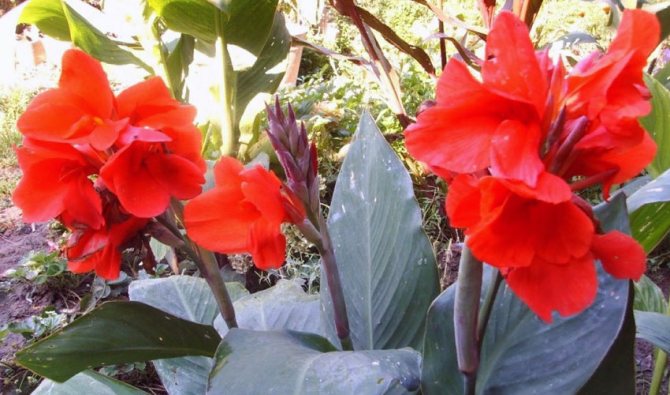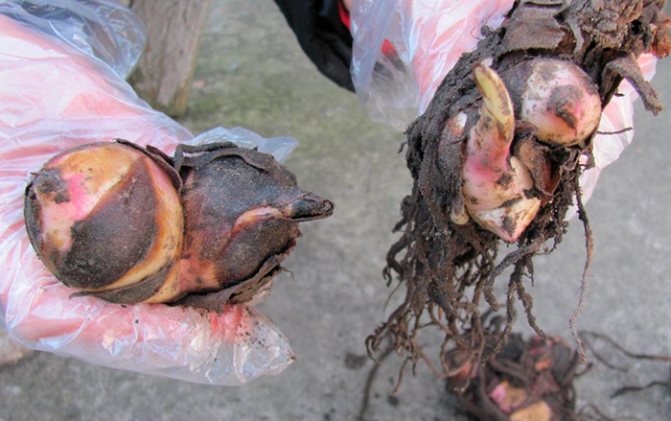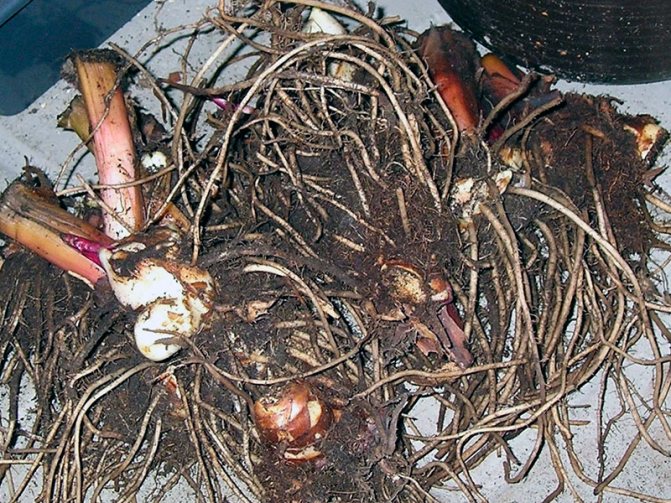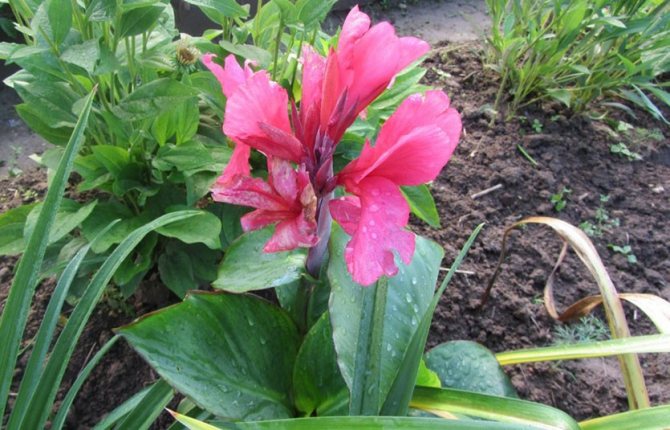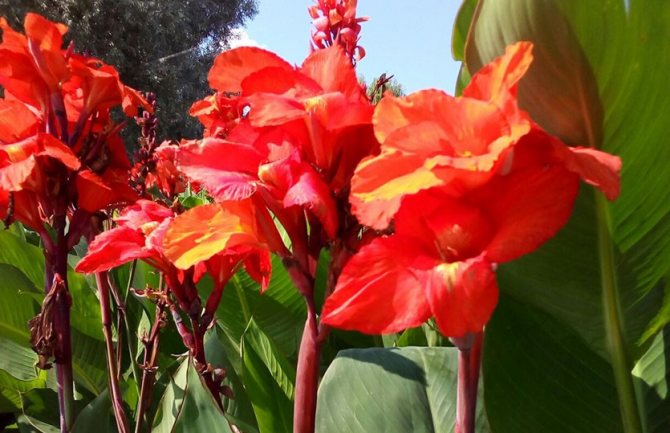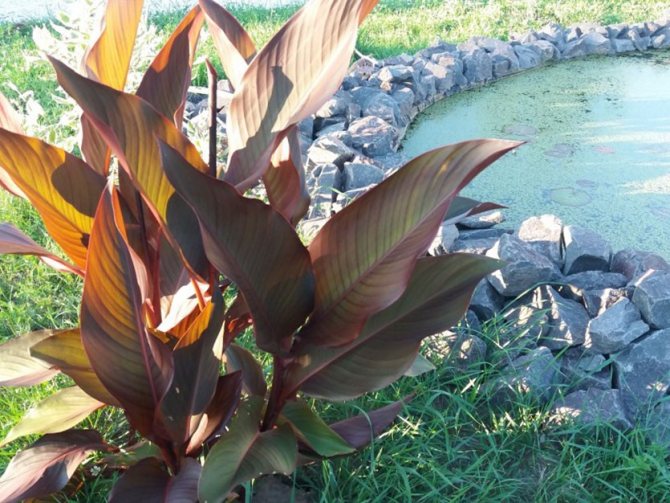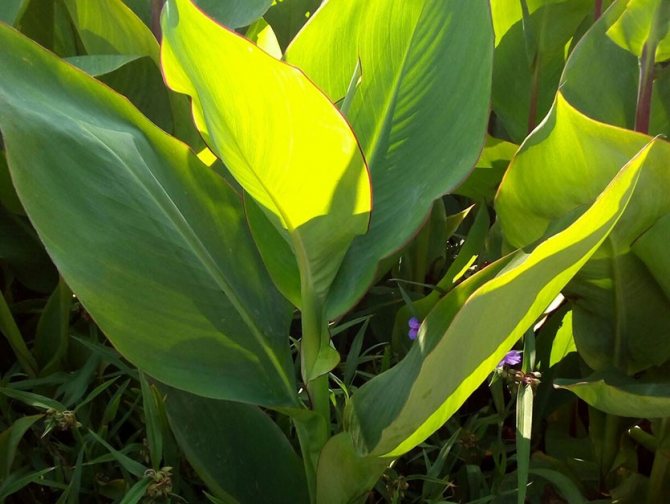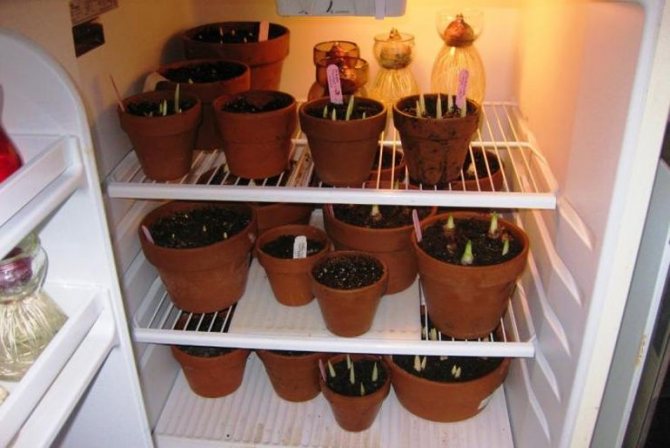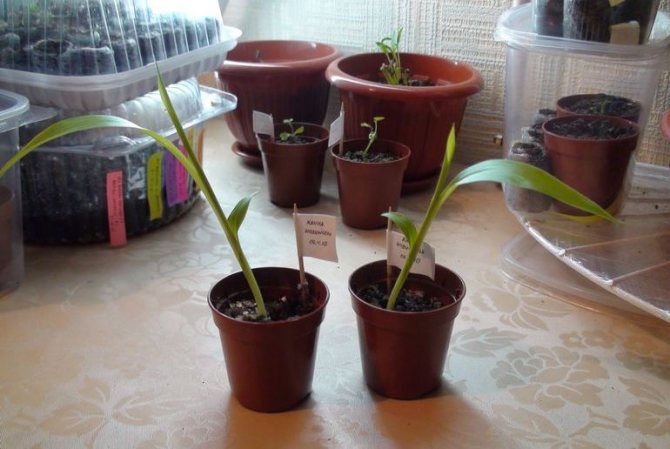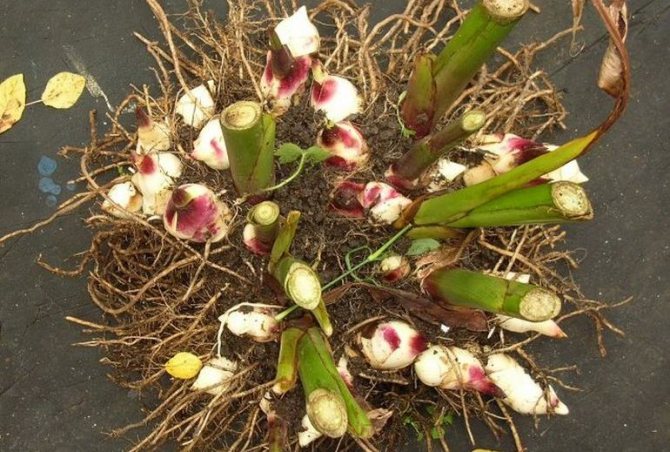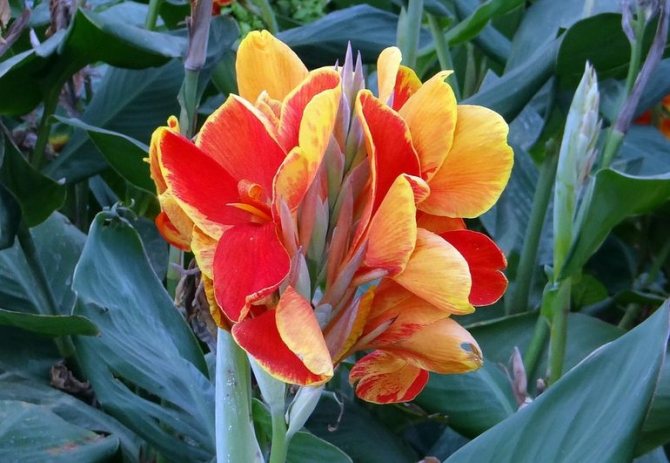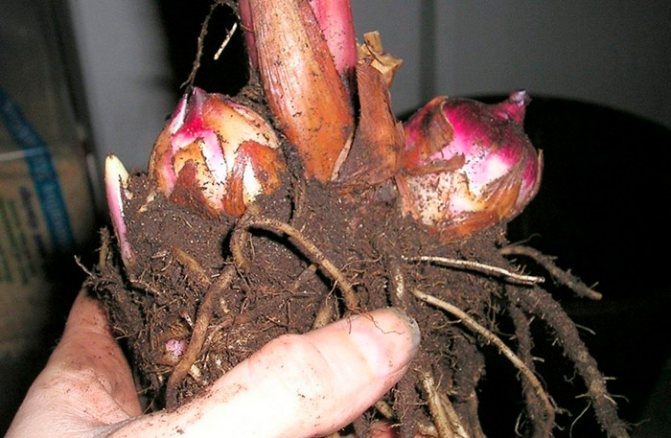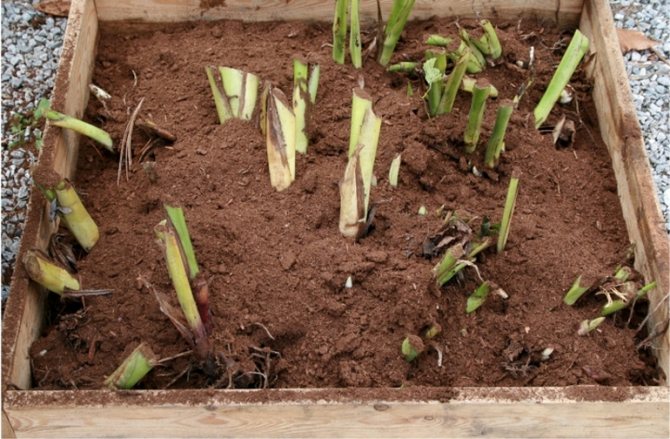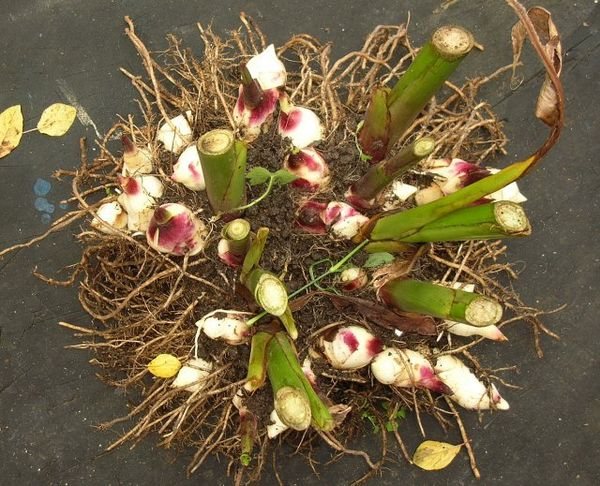
Recently, these exotic flowers have become an adornment of the backyard area of every private household, country house or summer cottage. However, most amateur gardeners do not know how to properly care for these beautiful plants with large leaves and large peduncles. We are talking about cannes - tropical perennial plants with a height of 80 to 150 cm and flowers, striking variety of colors... For the winter, the plants must be dug up, and the tubers must be stored under certain conditions.
Unfortunately, like all tropical "beauties", cannes do not tolerate the harsh winters of the middle zone, so most plants die in the cold period and do not survive until spring.
Cannes in autumn - preparing for digging
Cannes must be kept in a frost-free place in winter. starts at the end of summer. In mid-August, watering is reduced; for two weeks before digging cannes, they are not carried out at all. The canna rhizome should be dug immediately before the first frosts. The rhizome is carefully dug up and taken out together with a clod of earth. An inspection is carried out, during which damaged and diseased tubers are removed. Only healthy cannes tubers with growth buds are left for storage.
When to send for storage
It all depends on the climate of the region where you live. In the north, night frosts begin in September. Therefore, cannes should be hidden in mid or late August. When the heat lasts until the end of autumn, they are dug up until November.
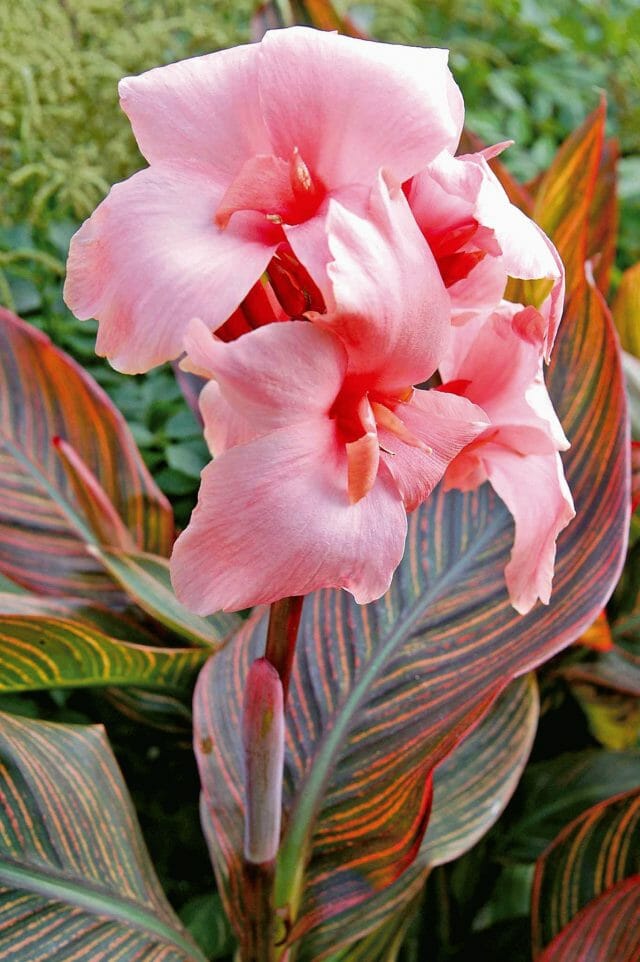

Cannes must be hidden in mid or late August
Even a single frost can destroy the bush. As soon as the temperature starts tending to 0 ° C, immediately remove it from the street.
How to store cannes in winter
There are several popular ways to store cannes in winter.
Cannes storage indoors
Before digging a canna, its stem must be cut at a height of 15 cm from the ground. After that, the canna rhizome is removed from the soil. The dug tubers should be allowed to dry for 24 hours at a temperature of 10 ºC. In parallel, you can treat the cut sites with a fungicide or a solution of potassium permanganate. Tubers are put in boxes, buckets or ordinary plastic bags, sprinkled with peat or moist loose earth on top. Cannes are stored in this form until spring at a temperature not higher than 8 ºC, but not lower than 4 ºC. The room where the tubers lie should be regularly ventilated.
Cannes storage with germination until spring
We remove the cannes from the ground and cut them off, as described in the previous paragraph. We do not clean the tubers from the ground, but plant them with an earthy clod in boxes, containers or flowerpots, which must be placed in a bright room, the temperature in which is maintained at + 12-15 ºC. Throughout the entire storage period, the soil will need to be slightly moistened, but not poured. During the winter, buds will form on the cannes tubers, which will fully ripen by spring.
Storing cannes in the refrigerator
If there is space in the refrigerator, and there are few cannes tubers, then they can be stored in the vegetable compartment. The roots are dug up, washed from the ground, disinfected with a weak solution of potassium permanganate. How to store cannes in the refrigerator?
Cannes tubers, before storing, need to be allowed to dry for a day in a warm room, after which they are wrapped in a damp newspaper, put in a plastic container and sent to the refrigerator, from where it is removed only with the arrival of spring.
How to dig up plants correctly?
Before digging out the rhizomes from the plant, you need to cut off all the peduncles, leaving a stump about 20 cm long. Then the perennial is carefully dug in and removed from the ground. There is no need to remove the soil from the roots, wash them - the remnants of the soil will help not to lose the necessary moisture in winter.Before storing flowers, they need to be dried in the shade for several days. This is best done under a shed or shed.
If you have several varieties of this ornamental plant, attach a tag with the name of the variety to the remainder of the peduncle. It can be made from thick foil, cardboard, plastic. In the spring, it will be easier to create a flower arrangement, taking into account the characteristics of the variety.
It is imperative to inspect the dug tubers, removing spoiled, rotten roots with buds. This is a convenient opportunity to divide the plant, leaving 1-2 healthy buds on each tuber. The cut points must be dried and sprinkled with crushed coal for disinfection. Experienced growers advise to postpone the division of the perennial until spring, when it will be clear how the plant has wintered.
Cannes flowering at home before the New Year
Canna can please with flowering for the new year, you just need to dig it out earlier than it is done for bookmarking for winter storage, and do not cut off the stem. The dug plant, which has lush green foliage, must be planted in a pot with soil, brought into the room and watered. When storing at home, cannes will delight the owners with flowering for several months. They will rest for two winter months, during which watering stops. The leaves will dry out during this period, and when the plant begins to revive, then the dormant period is over.
You have learned how to store cannes, choose the method that suits you. Good luck!
Rate the article
Basement preparation
Before laying tubers for wintering in a basement or cellar, you need to make sure that the conditions in the room are suitable for this. To keep cannes flowers throughout the winter, you must adhere to the rules:
- The storage of tubers is carried out at a temperature not less than 0 ° C and not more than + 7 ° C. If the temperature regime exceeds this mark, then the cannes may wake up ahead of time.
- Indoor humidity ranges from 85 to 90%. In case of deviation from these indicators, the tubers of the plant may dry out or rot.
- The basement is well ventilated. There is no mold.
During the wintering process, canna flowers must be inspected to make sure that there are no diseased plants. The specified parameters can be created in the apartment, for example, on a closed loggia or a balcony, which is located on the south side.


Cannes in autumn - preparing for digging
Cannes must be kept in a frost-free place in winter. The preparation of flowers for storage begins at the end of summer. In mid-August, watering is reduced; for two weeks before digging cannes, they are not carried out at all. The canna rhizome should be dug immediately before the first frosts. The rhizome is carefully dug up and taken out together with a clod of earth. An inspection is carried out, during which damaged and diseased tubers are removed. Only healthy cannes tubers with growth buds are left for storage.
Read about planting and caring for a cannabis garden
The timing of digging cannes
Each plant needs the roots or bulbs to receive as much nutrients as possible - this makes it possible to painlessly endure the period of winter dormancy. The signal is a steady drop in the ambient temperature. For a plant like cannes, this is the period after the first frost. Cooling serves as a signal that it is time to prepare for wintering, and therefore, all nutrients rush to the rhizome.
Keep in any form a short diary of the main work in the garden, in the flower garden, in the garden. Regular records will help you better prepare for technological operations, stock up inventory, containers, seeds and seedlings in advance.
This ensures that the plant will be able to begin a new vegetative cycle in the spring. For the middle zone, this period will be the end of September - the beginning of October, for more southern regions, the dates are somewhat shifted.If you start the digging process before the first frost, then the root system will go overwintering without receiving sufficient nutrition.
How to store cannes in winter
There are several popular ways to store cannes in winter.
Cannes storage indoors
Before digging a canna, its stem must be cut at a height of 15 cm from the ground. After that, the canna rhizome is removed from the soil. The dug tubers should be allowed to dry for 24 hours at a temperature of 10 ºC. In parallel, you can treat the cut sites with a fungicide or a solution of potassium permanganate. Tubers are put in boxes, buckets or ordinary plastic bags, sprinkled with peat or moist loose earth on top. Cannes are stored in this form until spring at a temperature not higher than 8 ºC, but not lower than 4 ºC. The room where the tubers lie should be regularly ventilated.
Cannes storage with germination until spring
We remove the cannes from the ground and cut them off, as described in the previous paragraph. We do not clean the tubers from the ground, but plant them with an earthy clod in boxes, containers or flowerpots, which must be placed in a bright room, the temperature in which is maintained at + 12-15 ºC. Throughout the entire storage period, the soil will need to be slightly moistened, but not poured. During the winter, buds will form on the cannes tubers, which will fully ripen by spring.
Storing cannes in the refrigerator
If there is room in the refrigerator, and there are few cannes tubers, then they can be stored in the vegetable compartment. The roots are dug up, washed from the ground, disinfected with a weak solution of potassium permanganate. How to store cannes in the refrigerator?
Cannes tubers, before storing, need to be allowed to dry for a day in a warm room, after which they are wrapped in a damp newspaper, put in a plastic container and sent to the refrigerator, from where it is removed only with the arrival of spring.
Storage bookmark
There are several ways to save this flower in winter. First, you need to prepare containers in which storage will take place, as well as peat, sand, sawdust and a thermometer to measure the air temperature in the room.
Let's describe the most common methods.
- Storage in cardboard boxes, wooden boxes.
Canna tubers are placed in containers, sprinkled with a mixture of sand, sawdust, high-moor peat. It is advisable to take sawdust for the substrate from fruit trees.
The optimum temperature for such storage is + 8 ° C. The substrate needs to be moistened from time to time, but not too much to prevent rot. This temperature regime and optimal humidity can be created in the cellar or in the basement.
Every month you need to revise the tubers, cutting off rotten places and sprinkling with ash or coal, ground cinnamon. Dry soil is additionally moistened.
- Potted storage.
A flower with cut peduncles, together with a lump of earth, is placed in a cool, light room. It can be a loggia or a veranda, that is, a room where the temperature does not rise above 13⁰С. This method mimics the natural conditions of the tropical winter to which the cannes are accustomed, it guarantees excellent preservation and maturation of flower buds. The soil is watered once a month, but not too abundantly.
The frequency of watering closer to planting a perennial in a flower bed should be increased, before planting in May - to feed it with full mineral fertilizer for ornamental plants.
- Storage in a flower container.
This way you can store cannes while enjoying their bloom. Here it is important to have time to dig up flowers before the first frost. Their peduncle is not cut off, since the perennial continues to bloom at home. This method is perfect for small varieties, although if there is enough space, the conservatory will only benefit from cannes of any size. Caring for such plants is slightly different - they need to be watered and fed regularly, and placed in the brightest place at home.Perennial flowering can be admired until January.
In order not to weaken the plant, it needs to provide a dormant period from February to April by cutting off dry leaves and limiting watering.
Cannes flowering at home before the New Year
Canna can please with flowering for the new year, you just need to dig it out earlier than it is done for bookmarking for winter storage, and do not cut off the stem. The dug plant, which has lush green foliage, must be planted in a pot with soil, brought into the room and watered. When storing at home, cannes will delight the owners with flowering for several months. They will rest for two winter months, during which watering stops. The leaves will dry out during this period, and when the plant begins to revive, then the dormant period is over.
You have learned how to store cannes, choose the method that suits you. Good luck!
Tagged
Cannes
- one of the few flowering plants that bloom until the first frost. Despite this, the problem of the safety of flower tubers should be taken seriously. The ability of a plant to bloom for a long time and withstand adverse weather conditions does not mean at all that its roots are as hardy as it is itself.
Canna is a perennial flower with long straight stems (from 50 cm to 3 m) and large rhizomes resembling tubers. The leaves of the plant are large, elliptical, oval, green, burgundy, with and without a border, with various shades, 10-30 cm long and 25-90 cm wide.The shades of flowers are also very different: from white and cream to red and pink. The petals of these flowers are decorated with a fringe or rim. They don't smell.
Cannes species have small flowers with powerful leaves. They differ in flowering time: early varieties bloom earlier by 2 weeks or even a month.
Cannes begin to bloom from the 2nd half of June, and flowering ends, as already mentioned, with the first frosts.
These flowers can be used for landscaping areas near fences, in the alley, around water bodies, since they have a powerful stem. For planting near fences, the variety "canna hybrid" (Canna hybrida) is usually chosen, obtained as a result of selection work with the best natural species.
As a rule, for novice gardeners, the question of the timing of planting and flowering of cannes takes less than the question of their storage.
How to keep Cannes until spring
Canna garden - a magnificent ornamental plant , which is appreciated not only for its original flowering, but also for its exotic beautiful leaves. Cannes have a powerful tuberous rhizome, from which erect tall stems with large leaves grow. Canna, due to its size and shape in the flower garden, always attracts attention, this plant can be a tapeworm. If you plant cannes in a row, then they form a solid green hedge.
Despite its tropical origin, cannes are successfully grown in regions with cold winters. ... However, it should be remembered that this is a thermophilic plant that is afraid of frost and actively grows only at temperatures above +20 degrees. For long-term cultivation of cannes, the rhizomes of the plant are dug up and stored in a cool place until spring.
When to dig cannes?
Most gardeners dig up cannes after the first frost. Usually, the first wave of short-term cold snap with temperatures down to -1 ..- 3 degrees takes place in September, after which the leaves of the cannes die and the plant loses its decorative effect. So that frosts do not damage the bases of the rhizome and buds located at the surface of the earth, it is recommended to spud the bases of the bushes at the end of August.
Without waiting for serious frosts, the cannes rhizomes need to be dug up and transferred to storage.
It is recommended to dig Cannes in dry weather. If you dig up cannes from wet soil after rains, then the risk of rotting during storage increases.
First, cut the stems at a height of about 10 cm. When digging up the rhizomes, step back 15 centimeters from the stem and stick in a shovel or pitchfork.Since the rhizome grows horizontally in breadth, located at the surface of the earth, the rhizome must be dug around and pulled out of the ground.
After removing the tuberous rhizome, it is not necessary to peel or wash it from the ground.
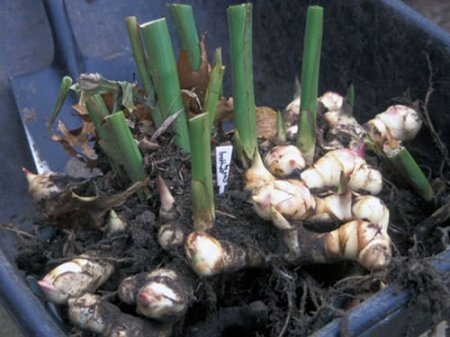

How to store cannes in winter?
Cannes tuberous rhizomes are well stored in a coma of dry earth, while they are able to ripen, their roots do not dry out until spring. Place the forged rhizome with a lump of earth in a box covered with a bag or newspaper, cover it with dry sand or perlite on top. When folding the rhizomes into boxes, make sure that the tuberous processes do not break, and the buds are not damaged, since they will give new shoots in the next season.
If the cannes were planted in a pot, then after the ground part at a height of 10 cm, they are rearranged in a storage facility, for example, in the basement, the cannes will remain in the ground until spring, and when they begin to germinate, they are transplanted into another pot with new soil.
Cannes are great for growing in pots or containers of the size corresponding to the volume of the rhizome. Planted cannes in a container can be rearranged in the summer in a flower garden, filling empty spaces, for example, after bulbous flowers.
It is convenient to grow cannes in containers, in the fall they do not need to be dug out or the rhizome removed from the ground, so it will not get damaged, just cut the stems and transfer them to storage. In the spring, the rhizomes will begin to sprout, they are removed from the container, if necessary, they are divided and planted in new soil. After the threat of frost has passed, the pots with grown cannes are placed in the garden and they will bloom earlier than the planted rhizomes at the end of May.
Cannes storage conditions:
You need to store cannes in a dry place. There is no place for cannes in the cellar where the potatoes are located or in the storage together with the dahlias, since there is high humidity and the temperature is below +4 degrees. Gangnam needs a higher temperature and a dry storage room, and they tend to rot when the humidity is low. A favorable temperature for storing cannes is from +5 to +10 degrees, but if the temperature rises above +12 degrees, the rhizomes can begin to grow, then thin weak shoots are formed that deplete the rhizome.
If during storage some parts of the rhizome began to rot, they need to be cut off, and the wounds should be treated with brilliant green or crushed charcoal.
How to store cannes bulbs?
- To begin with, the plant itself should be prepared for storage. Cannes are dug at the end of October, in dry weather. Tall bushes are dug in from all sides, gently shaken. All the earth must be shaken off, otherwise, during storage, the rhizomes (bulbs) may dry out.
- Cut the leaves and stems at a height of 20-22 cm.
- If you forget what varieties of flowers you are planting in your area, attach a label with the name to one of the bulbs.
- Arrange the plants in one row in boxes and store them in storage. There, in about 1-2 weeks, the stems will be slightly pulled up.
In a refrigerator
Cannes storage conditions will not be fully respected on the refrigerator shelf. Therefore, it is possible to resort to this method of winter preservation of flowers in exceptional circumstances.
- The plant is preliminarily cut, leaving a small part of the stems (12 - 15 cm), and then the cuts are cauterized with iodine.
- The subsequent washing of the roots is carried out in running water, and then they are kept in potassium permanganate for at least a day.
- Then the rhizomes are dried well, wrapped in damp paper and folded in plastic containers with a large number of holes.
In order to notice the decay processes in a timely manner or to prevent drying out of flower roots, their condition should be constantly monitored (inspection should occur every 20 to 30 days).
Cannes tubers: storage
Cannes tolerates transplantation well. If the plant is left with flowering inflorescences, you can plant them in containers or pots.And they will delight you with their appearance, but only at home.
The tubers are stored until warm. Then they are separated and planted.
A correctly chosen place for storing such a flower is very important not only for preserving the rhizome, but also for the future productivity of flowering. Store the plant in a dry basement, a cool room, grooves in the front garden, but always and everywhere at a temperature of + 8-12 degrees.
A special example is the storage of bulbs on site. Place the uncut rhizomes in the grooves, sprinkle with soil. The green tops will wither little by little. In this case, the buried part will not dry out. It is necessary to maintain the plant at this level until the beginning of spring. As you can see, this option is the most risky.
Without preliminary germination, the canna will not have time to bloom. Therefore, in the spring, it is imperative to remove the roots from the container or dig up, and plant them in pots.
Tuber preparation
The weather will tell you that it's time to remove the bulbs from the ground. It is necessary to prepare a flower for wintering immediately after the first frost. If you do this earlier, the canna will not have time to stock up on nutrients, which begins to accumulate with a decrease in temperature. Late digging is fraught with freezing and death of the root system.
To properly prepare the tubers, proceed as follows:
- Cut off all the stalks, leaving a stump 10-20 cm high.
- Spray the slices with a fungicide to prevent disease.
- After this, keep the root in the ground for a few more days.
- Remove the bulbs carefully.
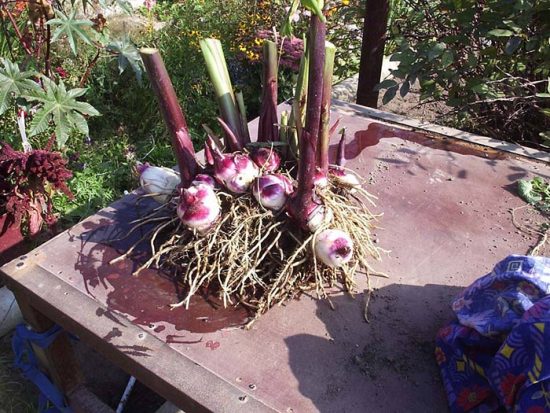

Advice. If you are growing multiple varieties, label each bulb with a plastic or cardboard variety tag before storing it. In the spring, this information will help you create a beautiful flower bed, taking into account the varietal characteristics of crops.
How to store cannes for the winter?
- When the first frosts come, cut the cannes, but leave 15 cm, dig out the entire rhizome. Shake the rhizomes from the ground, dry, put in paper bags (cardboard boxes), cover completely with earth. Place in a cellar or basement.
- During storage, the tubers must be inspected at least once a month. If you notice rot that has appeared on them, remove it to a healthy base, and sprinkle the cut area with charcoal.
- Rhizomes with an earthen lump, cut off at a height of 10-15 cm with a stem, can also be transplanted into pots and stored in bright rooms at a temperature of 12-15 degrees, watering in moderation. Throughout the winter, the buds will grow slowly and ripen well.
- At the end of February, remove the roots, cut them off. Most likely, they will wither and dry up. Transfer the bulbs to a shallow container (such as a plastic cake lid) and place in a bright, warm place. Don't forget to water. When sprouts appear, place them on a table or windowsill, followed by planting in the garden.
- If you bought cannes tubers early, then it is better not to store them, but immediately subject them to an antiseptic treatment and plant them in a container, and later plant them.
- In March or April, divide the rhizomes by the number of young shoots, plant them in pots so that they grow up. Plant on open ground at a time when the threat of frost recedes.
- Make a deep hole for planting, pour manure into it, then a layer of earth, put cann roots. Pour earth on top so that you can still pour a bucket of sand on top. Remember to water the plant well (at least 2 times a week).
- If you do not have a front garden, do not worry, cannes can not only be stored, but also grown at home. Plant them in large boxes, pots, or tubs. In the room, they can bloom almost all year round, being satisfied in the winter with a slight rest period lasting up to 2.5 months. This period is marked by the fact that almost all the leaves of the plant dry up, but after a while new shoots begin to grow.
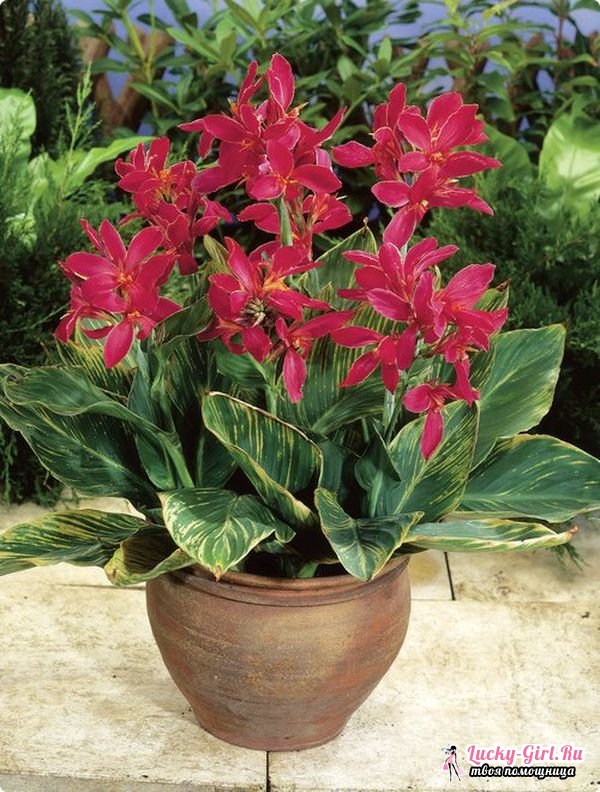

By the way, growing cannes at home is another way to store them. The grown flower can be planted in the garden.And then the problems with courtship will disappear by themselves.
As you can see, tubers of a seemingly hardy and frost-resistant flower need to be looked after during the cold season. However, your efforts will not be in vain. The bulb saved in winter will sprout, and a wonderful and cute flower will bloom. Use any of the root storage methods, grow flowers. Create your own little beautiful corner to relax from the hustle and bustle of the surrounding world.
Good day, readers of the blog "Whether in the garden, in my garden."
I hope in this article to introduce you to the amazing Cannes flower. You may have seen it, but did not know the name. I will tell you how to grow cannes, how to store them in the winter.
I really liked these flowers for their colorful original flowers, colors and wide leaves. Cannes often decorate flower beds in front of government offices and look luxurious. It turns out that this exotic southerner can be grown in her garden, and she also grows well at home. A large number of varieties have appeared on the flower market and you can choose the variety you like the most.
The main problem in growing cannes
- preserving them in winter and proper preparation for spring planting, as well as the problem of all flowers that need to be dug out for the winter. Cannes has its own characteristics, I will tell you about them later. Cannes are not pretentious and grow both in a single planting perfectly, and in a mix with other plants. They love the sun very much, they are not afraid of the scorching rays, the flowers only become brighter. But if they are planted in the shade, then you can not wait for flowers at all, they will take on the appearance of tropical giants with huge wide leaves.
Cannes can delight us with its bright colors from July to September, if you choose the right variety and prepare them in spring.
Among the many varieties of cannes, you can choose the one that is best suited for your site and the place allotted to it. Some varieties, instead of bright flowers, will delight you with beautiful veined leaves. Cannes are also different in height, not all meter and two-meter giants, some are 50 cm tall.
Indika and Glauka are aquatic plants, they thrive in a humid atmosphere all year round, creating an exotic look near the pond.
1. Choose the right variety and planting site so that the plant receives enough light for flowering and warmth. Cannes do not like winds, because they are southerners do not forget about it. In a semi-shaded area, the leaves turn pale, and variegated varieties lose some of the stripes and strokes.
2. In our short summer, cannes may not bloom at all, so they must be germinated in mid-March either at home or in a greenhouse. It is necessary to divide the rhizome in the same way as, leaving several buds on the plot.
3. Landing in open ground is carried out at the end of April, when the threat of frost has passed and the ground warms up. The soil for cannes needs well-fertilized, light and balanced.
4. It is not necessary to plant them close to each other, they grow very quickly into a huge bush. We dig a hole about half a meter deep, horse manure can be placed on the bottom with a layer of about 20 cm (for warmth), and on top of the nutrient soil with a layer of 25-30 cm. The soil is slightly moistened and we plant a root with sprouts to a depth of 10 cm. Pour with water, always warm. With this planting, cannes quickly take root and grow. A month after planting, the plant will bloom and will bloom all summer.
5. Over the summer, cannes need to be weeded several times and loosened. In order for the cannes to begin to grow vigorously, it is necessary to water abundantly with warm water, and by the end of summer (August) reduce the amount of watering for better ripening of the roots.
6. Once a month, mandatory fertilizing with mineral complex fertilizers, first spill the soil with water and only after 2 hours you can do additional fertilizing so as not to burn the young roots.
7. Cannes bloom gradually, one inflorescence blooms, then another, flowering begins from the bottom.So from July to the coldest days. In September, cannes need to be covered with earth to a height of 15-20 cm in order to protect the roots from cold winds and frost at night.
Storage in a cellar or basement
Cannes storage for the winter can be arranged in the cellar or basement. Previously, the room will need to be prepared: take out all unnecessary, clean the walls and floor from mold and treat with an antifungal compound. These measures will help protect the plant from mold that can kill it.
In addition, the premises must meet the following requirements:
- constant air temperature not lower than 0 ° C;
- air humidity 90-95%.
During digging, the plant itself should be cut off, leaving a short stem 10-15 cm long. Sections can be treated with a fungicide to protect cannes from diseases. Further, the preparation of tubers will consist in drying them, for this, after digging them up, they are left in the open air (under a canopy) for 3-4 days.
When the roots dry up, they need to be placed in wooden boxes, sprinkled with peat, sand, humus or sawdust for better preservation and transferred to the cellar.
During the storage period, it is worthwhile to view the plants once a month, if necessary, moisten them with a spray bottle (soil moisture should be about 50%). In addition, you need to carefully monitor that rot does not appear. If it appears, you need to cut off all the affected areas and sprinkle the cut with charcoal or treat with iodine.
How to store cannes in winter
So we come to the main problem of storing cannons rhizomes. At the end of September and beginning of October, the cannes should be cut to a height of 10 cm above the root collar. The roots must be dug out with a lump of earth and placed in boxes with peat or sand. Drain into the basement and store at a temperature of +5 +7 degrees C. Constantly check the roots, do not let them dry out, be sure to moisturize. The fact is that cannes do not have a dormant state, like other plants in winter. They stay awake all winter.
As an option
, if there is no basement or warm cellar, it can be stored in a plastic bucket with sand (peat) on a glazed loggia, but only until November. Then the bucket must be brought into the kitchen and placed against the balcony door.
For low varieties of cannes, another storage option is possible in winter.
In the fall, plant the cannes in pots and put them on the windowsill at home, reduce watering to 2 times a month. In the spring, plant in your favorite garden area by dividing the plants.
Cannes are resistant to various diseases, which is undoubtedly a plus in growing, but aphids can take a fancy to your exotic flowers. Here you will have to use aphid insecticides.
Cannes are amazing flowers, the main thing is that even an allergic person can grow them, since they are odorless.
Now you have idea of how to grow cannes, how to store cannes
and what a beautiful exotic flower he is.
On my garden plot, I grow a variety of flowers - from humble daisies to luxurious roses. Among them there are representatives of the tropical flora, the most luxurious of which is the canna. These graceful and bright flowers delight the eye with their flowering until late autumn.
The main thing is to help the heat-loving canna to survive the cold. If you decide to decorate your garden too, then I will gladly share with you the experience of planting and caring.
Cannes is considered to be the South American continent, but it also grows in India, Indonesia and the islands of the Hawaiian archipelago. In addition to spectacular flowering, the plant has a lot of valuable qualities.
For example, the inhabitants of the tropics use its baked root in their dishes, it is very rich in starch. Foliage and stems contain a lot of vitamins and go well with animal feed.
The plant grows from 0.5 to two meters, depending on the variety. The canna stem, which resembles a reed, is covered with large leaf blades of the most incredible colors.
The flowers themselves are lemon, snow-white, crimson, burgundy. Hybrid varieties are found with stripes and specks. Cannes bloom from mid-June to November.
One of the features of canna is the lack of aroma. For some, this may be a disadvantage, but people prone to allergies will be able to admire the flowers without any fear.
Varieties
Canna, which has almost 50 varieties, is the only one of its kind. Not only canna flowers look decorative and catchy, but also its leaves. The most popular varieties for growing in personal plots are:
- Livadia;
- Richard Wallis;
- Clara Buisson;
- The president.
Cannes storage
In the basement or cellar
For storage in boxes, the leaves should be cut to a height of 20 cmand then dry under a canopy with fresh air.
After that, the wooden boxes are filled with peat mixed in equal proportions with sand and sawdust, the mixture is moistened and the dried rhizomes are placed there. Store in a cellar or basement at a humidity of no more than 60% and temperature from +5 to +8 degrees.
Watering and inspection should be carried out at least 1 time per month.
At rest
You can store the flower on the veranda, loggia, closed balcony at a temperature not lower than +12 and not higher than +15 degrees... Canna should be watered once every two weeks. Care should be taken to ensure that the soil is not too moist, as this can lead to root rot.
No pruning required when stored in a pot
As a houseplant at home
Cannes thrive in indoor conditions, so in winter they can be grown like ordinary indoor flowers at home with proper care.
In this case, the main condition is spacious pot or another container where you can plant a flower without any problems. For filling, ordinary garden soil or a mixture of peat sand and sawdust, taken in equal proportions, is suitable.
When digging from the bush, remove only dried flowers and leaves, and a bush with an earthen lump is transferred to a prepared pot or spacious container.
Cannes loves sunlight, so the flower should be placed close to a window or balcony door. Under such conditions, the plant continues to bloom until mid-December, after which a dormant period begins for 1.5 - 2.5 months.
For room storage, you need to choose a light window sill
For indoor cultivation, water the plant in a timely manner and apply fertilizing from mineral fertilizers or mixtures for any indoor flowers once every 30 days.
In mid-April, you can begin to gradually harden the flower, taking it out to the balcony or open terrace during the day. At night, the plant is taken back to the room. And landing in open ground can be carried out only after the establishment of warm weather, without night frosts.
In order for Cannes to delight the gardener for more than one year, it is very important to create conditions for them, close to their natural environment habitat. In summer, it is warm and abundant in moisture, and in winter, it is cool and moderate watering.
For their care and trouble, these exotic flowers will fully reward their owner with bright greens of large leaves and variegated colors of large flowers.
Planting and caring for a plant in the open field
As soon as you decide to plant a canna, then start looking for a suitable place. The site should be exposed to sunlight, without drafts and shade. The plant is tropical, it does not tolerate cold at all. Be sure to consider protection from the winds, as in case of strong gusts, the stem can break.
When your canna grows up, it needs to create support. The plant will thrive in a loosened area with plenty of light. Canna also grows in the shade, but you can not wait for its luxurious flowering.
The flower does not require much attention and special care, practically does not get sick. The plant tolerates frost well, but does not overwinter on the site.
Watering these flowers is easy too.The soil should always be slightly damp, and water abundantly during flowering. Remember! Although the canna loves moisture, you cannot fill it with it.
Reproduction methods
The plant can be propagated in two ways: by seeds and by dividing the root. As a rule, planting material is prepared at the beginning of the spring. To do this, you need:
- Thoroughly clean the roots from the soil.
- Divide them with a clerical or construction knife, cut the cut well with crushed charcoal.
- Trim the roots to 5 centimeters.
- Leave the separated material to dry in a well-lit, ventilated room. The temperature in it should be +10 - +15 degrees.
- As soon as the sprouts have awakened, the material is planted in containers with a vitamin substrate, installed in heated rooms.
Seed planting
The sowing of the seeds is carried out earlier than the division of the root. The best time for this is the middle of winter. The seeds are prepared as follows:
- the shell must be rubbed with sandpaper, so shoots will appear faster;
- for good germination, the seeds must be soaked in a growth activator before planting.
A very important point! Properly prepared seeds will sprout in 28-35 days. Without these manipulations, the terms can stretch for several months.
For seedlings, you can use a ready-made universal earth mixture. You can also cook it yourself. This requires:
- one piece of turf;
- two parts of peat with humus;
- half of the sand.
Containers with seeds are kept in rooms where the temperature does not drop below +25 degrees. As soon as the seedlings have two leaves, they are seated in separate containers. Before you plant the seedlings on the site, it must be quenched.
Every day we expose the seedlings to the street, in partial shade. In the first days, we leave the containers for no more than 10-15 minutes. After 7-10 days, you can leave it on for two to three hours. The best time to transplant to a permanent place is the second decade of May, if the threat of night frosts has already passed.
Plant feeding
Correct and regular feeding is the key to a long and lush flowering. Suitable for fertilization:
- bird droppings (chicken) diluted with water at the rate of one part of droppings to ten parts of water. Plants must be fertilized once every 12-14 days, half a liter per bush;
- crushed charcoal is introduced in one hundred grams during the period of bud formation.
Why dig up flowers for the winter
The warmth-loving cannes, whose homeland is considered to be the tropics, are not able to withstand the harsh winter of our region. They will quickly freeze and will not give spring shoots. Therefore, with the arrival of autumn, flowers are dug up. And with the spring heat, they are again transplanted to the site.
Residents of the southern regions do not need to store cannes in winter. Flowers can remain in the soil in warm winters. In winter, the temperature should not drop below -5 ° C. They are insulated with available means (you can use spruce branches or needles, which are poured on top with a layer of at least 10 cm).
When winters are colder (below -6 ° C), flowers need to be dug out before night frosts. If this process is delayed, the root system will freeze and begin to rot.
Proper storage of cannes in winter at home begins with their timely extraction from the soil. For the middle lane, this time falls on September. And residents of the northern regions need to do this already in August.
Keeping cannes in winter
If cannes is grown in the garden a little, then they can survive the winter in the house, like indoor flowers. Before freezing, the bush must be dug out, leaving a clod of earth on the rhizome and placed in any suitable container. Until the end of winter, they are placed on the windowsill, watered moderately, but not fed.
Shoots on which the leaves are already turning yellow are cut to three centimeters. If there are a lot of flowers, then rhizomes with a lump of earth are laid in a container, covered with sawdust. Before that, they must be dried in the open air.
Here are all the simple rules, the implementation of which will give your plants a long life and abundant flowering.
When to dig cannes?
Canna is a perennial that, in our climate, does not tolerate winter in the open field. For this reason, its bulbous roots are dug up already during the first frost. Before this, the peduncles are cut off, leaving a 20-centimeter stump. Then they carefully dig it out without removing the soil from the rhizomes and without washing them out: the remnants of the soil retain moisture in winter. The dug rhizomes must be dried by placing them in the shade. The plant can then be divided, leaving healthy buds on each tuber. It is also permissible to postpone the division process until spring.
Storage conditions
A perennial plant native to America is considered unpretentious. Even inexperienced gardeners can grow it, since the flower does not require special maintenance conditions and does not need scrupulous care. But you should definitely dig cannes for the winter. The superficial root system of the plant, adapted to the tropical climate, is not able to withstand the harsh Russian frosts. Therefore, even residents of the southern regions should take care of storing cannes at home.
Regardless of the chosen place, the following conditions are considered optimal:
- temperature - from 0 to + 6 ... + 8 ° With higher thermometer readings, the bulb will begin to develop in the middle of winter. It is necessary to prevent a sharp temperature drop;
- humidity is between 80 and 90%. If this parameter is lower than recommended, the roots may lose moisture. In a waterlogged room, there is a risk of rotting tubers;
- good ventilation;
- quick access to bulbs. They need to be checked and inspected regularly, rotten roots should be removed.
In the basement
Before storing cannes after digging in a cellar or basement, their stems are shortened by 15 - 20 cm. Each damaged area is treated with a fungicide that prevents the development of plant diseases.
- It also requires drying the planting material in a ventilated place, closed from sunlight, which usually takes 3 to 4 days.
- For the storage of cannes in the cellar to be successful, the roots are placed in a wooden container using sand filler (peat, humus, sawdust can be used), after which the tubers are sent for wintering.
- The storage temperature of cannes in the cellar must be stable, within the range of 0 ° С- + 6 ° С.
- If the roots of flowers are frozen, their germination in spring will be a big question. And in a warmer and damp place, the planting material will sprout ahead of time. This will lead to the depletion of plants, and the impossibility of them to endure wintering.
- Humidity is considered normal for cannes not higher than 80%. In conditions of drier air, the roots wrinkle, and with increased dampness, they become moldy. To prevent this from happening, you need constant ventilation of the room.
- Storage of cannes roots in winter should take place under regular monitoring conditions. Once every 20 - 30 days, the planting material is moistened, if necessary, using a sprayer, preventing the soil from moistening over 50%.
- The appearance of rot is a sign of waterlogging. If this happens, all affected parts are cut off at the roots. After that, the sections are treated with an alcoholic solution of iodine or crushed ash.
A few words about the plant
Canna is a monoculture, that is, the only representative of the Cannaceae family. Under natural conditions, it grows in South and Central America, China, Indonesia, India.
The flower has thin erect stems that grow in height up to 3 m in some varieties.The leaves are lanceolate or oblong, rather large, can grow up to 80 cm in length and up to 25 cm in width.
Canna reveals its splendor during flowering. The main color of its buds is red, although breeders managed to breed varieties with yellow, white, orange, pink and even two-color petals - speckled or edged.The flowers grow up to 8 cm, they are bisexual, asymmetrically located on the flower arrow and are collected in an inflorescence - a panicle or a brush.
The flower has only two drawbacks: it does not tolerate our winter in the open field and has no smell. Among its advantages, gardeners distinguish the following:
- very rarely gets sick;
- growing rapidly;
- easy growing;
- easy care;
- decorates the site with its flowering until late autumn.
If the buds have been pollinated by insects, brown large seeds have time to ripen. They can be used for breeding.
In what time frame and how to dig cannes
They begin to dig up the rhizomes of the cannes when the first frosts have passed. Before that, you need to cut the stem of the flower at a height of 20 cm from the ground. During digging, you must act carefully, the fleshy rhizomes of this flower are very easily damaged.
Attention! In the process of digging, instead of a shovel, it is better to use a pitchfork, the risk of damage to the rhizomes in this case is much lower.
It is best to dig at a distance of 15-20 cm from the stems of the plant; an earthen lump is necessarily left on the rhizomes. After the dug out plants must be placed in a cool dry place for further drying.
Spring disembarkation
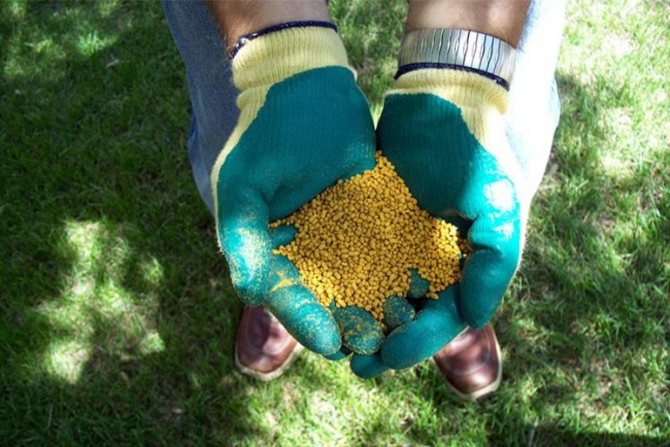

If the flowers have successfully overwintered in a cellar or apartment, and the spring season is just around the corner, it means that it is time to start preparing plants for planting outside. If they wintered in a pot, then in early April they are hardened. To do this, the culture is taken out on an open terrace or balcony, and taken back to the room at night. When stored in a cellar, basement or refrigerator, the roots are taken out and divided according to the number of new shoots (each element must have two shoots or healthy buds).
Important!
Each separated element is moved to a separate temporary container, on the bottom of which a suitable substrate of black soil, sand and peat is laid out. The soil in the pot is watered and fertilized with special fertilizing.
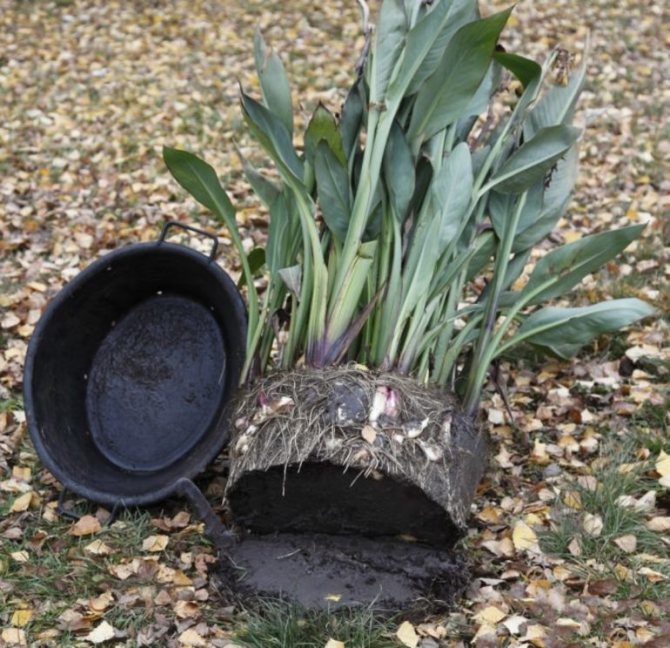

The final movement of cannes to open ground occurs at the beginning of the summer season. In order for the flowers to successfully take root in the new conditions and provide the gardener with abundant flowering, when choosing a planting site, preference should be given to slightly shaded or sunny areas with a good fertile substrate.
Immediately before disembarking, a hole is dug, and then water is poured into it. Only then can you start planting a flower. Subject to the basic rules, the lush flowering of a colorful exotic plant will begin in July or August. The time of appearance of flowering elements depends on both climatic conditions and varietal characteristics.
The process of storing cannes in winter is not difficult. You can save such flowers from frost in the cellar, on the glazed loggia, attic, in a city apartment and even in the refrigerator. There are a lot of opportunities and ways to protect crops from winter frosts. It remains to decide on a suitable option and start preparing. The success of wintering depends on the correct implementation of the preparatory procedures, the choice of a suitable place and regular inspections. After following all the rules, you can be sure of a lush and beautiful flowering when the warm season returns.
How to get out of wintering correctly?
If you plan to plant the plants directly in open ground, then in April you need to get the tubers out of the substrate and start adapting them to new conditions, bringing them to fresh air from a sunny day. Then each tuber is examined, the damage is sprinkled with ash, crushed coal, dipped in the root formation stimulator "Kornevin" and planted in a permanent place.
You can germinate perennials in pots in advance.
The composition of the germination mixture:
- sand - 1 part;
- humus - 1 part;
- fertile land - 2 parts.
In March, all the cuttings with the treated places of the cuts are planted in the substrate, sprinkled on top of 2 cm with soil, watered with warm water. After a week, the flower buds will begin to grow, and we can assume that a successful wintering is completed.
In order for an ornamental perennial to successfully winter, you need to create conditions close to those of a tropical winter - cool and moderate watering. It is necessary to constantly monitor the humidity, preventing the formation of rot. The reward for the patient and responsible grower will be the beautiful flowering of a strong and healthy plant.
How to care
Further care consists in watering, loosening the soil, combating weeds and feeding.
Leaving involves feeding three times a season. Once every 10 days, when watering, grains of manganese are placed under each flower (or diluted in water in an amount of 2 g per 10 liters of water). It is required to stimulate flowering.
The best types of fertilizers are mineral (containing nitrogen, phosphorus and potassium) and organic.
Their introduction is carried out by the root method: after watering, fertilizer granules are scattered around the bushes, and the soil is loosened. Before flowering, with an interval of 2 weeks, you can feed chicken droppings diluted in water 1:10.
Water the plant regularly, but in moderation. Abundant watering is necessary for a flower only before it blooms.
When watering canna, do not overdo it. An excess of moisture will provoke the development of bacterial and fungal diseases.
Care includes preserving the decorative appearance of the canna. To do this, she regularly needs to cut off faded flowers.
Growing canna is also possible at home - it is bred as a pot (tub) plant. In order for it to feel good and grow in winter, it is important to know some of the features of its cultivation at home.
In order for a flower to grow at home, it is enough to dig it out of the ground and place it in a pot for indoor plants with a diameter of at least 50 cm, having previously watered the garden soil with an insecticide. Such a procedure is necessary to avoid insects from moving into the premises.
Caring for a plant at home is even easier than in a flower garden. No need to spray it, remove weeds and loosen the soil. It is enough to put in a lighted room, water and feed with fertilizers. The room canna is in a dormant period for only 2 months, and the rest of the time it pleases with its beauty.
Proper and timely home care will preserve the beauty of the canna even after flowering is complete.
Plant after flowering
Indoor canna after flowering needs some rest. It is necessary to reduce watering daily, and then completely stop it. Then the leaves are cut and the pot with the plant is placed in a cool place where the temperature is at least 10 ºC. In the spring, the roots are removed from the soil, divided and planted in pots or open ground.
If the canna grew in the garden, then after flowering it also does not need abundant watering. It gradually shrinks and then stops. As soon as the first frosts begin, the stems are cut off, and the rhizomes are dug up along with the ground.
Nutrients are localized in the rhizome only after a cold snap. If you dig up flowers before frost, the roots will not receive the supply of substances necessary for wintering.
Before storing cannes, the rhizomes should be dried in the shade for 2-3 days. It is better to lay them out under a shed or in a shed.
Storage methods
In order for the wintering to be successful, it is enough to follow a number of simple care rules:
- The temperature during storage should not fall below 0 ° and rise above + 6 °. At higher temperatures, the cannes will wake up and start growing in the middle of winter.
- There must be good ventilation in the place where the rhizomes are stored.
- The optimum humidity for storing cannes is 80 to 90%. At a higher rate, the roots may rot, and at a lower rate, dry out.
Depending on the availability of certain possibilities, each grower chooses his own way of storing cannes until spring.
In a cellar or basement
The conditions in the cellar or basement are as close to optimal as possible. Therefore, this method is the most effective.
Before laying for storage, the rhizomes are examined for rot. If they are found, the affected areas must be cut out, after the place of cuts, treat with brilliant green or sprinkle with crushed charcoal.
Dried and processed cannes are placed in boxes or boxes directly with a lump of earth and covered with sawdust, peat or sand. During winter storage, they also require appropriate care; they must be examined at intervals of once a month for the presence of rot. If they are found, the damaged areas are cut out, and the roots themselves are treated with a fungicide, for example, "Maxim". You also need to monitor the moisture content, when the planting material begins to dry out, it must be sprinkled with water.
Attention! In boxes or boxes where cannes are stored, there must be openings for air access.
In the apartment
Not all growers have a basement or cellar at their disposal; some are forced to keep the tubers at home.
In this case, the dug out plants are planted in pots and brought into the room. Place the pots in a bright, preferably cool place and keep watering. With good care, they will continue to grow and even bloom until December.
After the flower, a dormant period will come, which will last about 2 months. During it, the plant will shed almost all the leaves. This should not be a cause for concern, new shoots will appear later.
Attention! In order to prevent decay of rhizomes, watering for the rest period must be reduced to a minimum.
In the absence of the possibility of growing cannes in pots, their tubers can be tried to be stored in boxes or boxes, which must be placed in the coldest place, for example, on a loggia or near a balcony door.
With this method of storage, pre-dried and processed cannes are folded into boxes and covered with a layer of sand, peat or sawdust. The most important thing in this case is to provide them with proper care: low temperature and complete absence of light.
In flower pots
Storing cannes in the winter at home is possible in flowerpots for indoor plants. However, they can be kept cool or left active.
When it is decided to give the flowers a "winter rest", they are planted without pruning, with their "native" soil in flower pots of suitable size. Then the pots are taken out onto a glazed veranda (balconies and loggias in a city apartment), where the temperature does not exceed + 12 ° С - + 15 ° С.
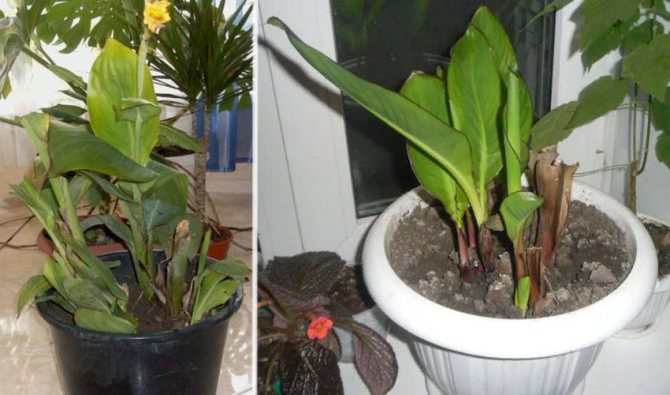

Watering plants during storage at rest should be done infrequently: once every 15 days. In this case, waterlogging of the soil should be avoided. Dampness contributes to the development of mold and root rot.
In winter, the canna can become a houseplant. Flowers will need spacious containers of garden soil that they are used to. Full pruning is not required when replanting. It will be enough to remove the dead parts of the stems and leaves.
As a substrate, you can also use a mixture in which sand, peat and sawdust are present (1: 1: 1).
Kanna prefers to be on a sunny windowsill. At the same time, its flowering is possible until 2 - 3 weeks of December. Then comes the resting time of the flower, which lasts 45 - 75 days.
Watering and feeding flowers will be required no more than 1 time in 30 days.
During the "winter rest" leaves and stems die off from flowers. New shoots will begin to appear only with the arrival of spring.
For the plant to gradually get used to the street, it is taken out in the daytime to fresh air. And in the evening they again bring it into the room. With the arrival of stable heat, the plants are planted in the garden plot.
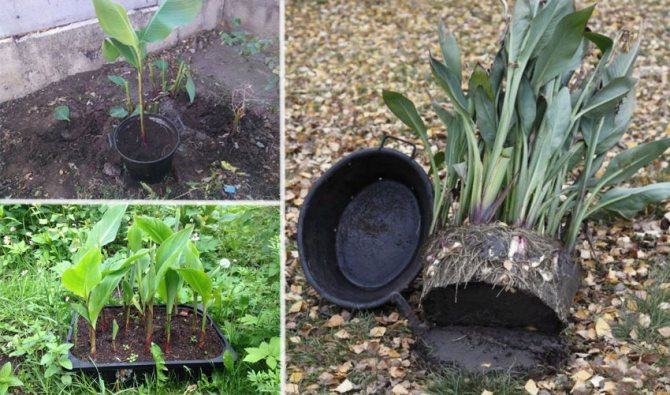

Cannes growing methods
Flower cultivation comes from seeds or rhizomes, divided in the fall. Sprouting tubers at home or growing a plant from seeds is a must for our climate.
How to grow a canna from seeds
The best time to sow seeds is the end of January or the beginning of February.
Growing canna in this way is more suitable for breeding work, since seedlings obtained from seeds in most cases do not retain varietal and species characteristics.
In order for the seeds to germinate well, their strong shell must be destroyed. To do this, you can use one of the following methods:
- pour over boiling water;
- hold for 3-4 hours in a thermos with warm water;
- put in the snow for 2-3 hours or in the freezer for 1 hour;
- destroy by mechanical action.
If you ignore this procedure, seed germination will deteriorate, and the emergence of seedlings will be delayed.
Then the seeds are soaked for 24 hours in a growth stimulator and only then are planted in a container with soil, the temperature of which before sowing should be at least 22 ºC. They are sealed to a depth of 7-10 mm, watered, covered with a film (glass). The first shoots will appear in about a month. When 3-4 leaves grow on them, they are dived (planted) in separate pots, in which the flowers are located before planting in open ground.
After picking, young seedlings are placed in a room where the temperature does not exceed 16-18 ºC.
How to grow from rhizome
Growing a flower from a rhizome is considered the easiest and most reliable way. At the end of March or the beginning of April, the stored rhizomes are cleared of the ground, their dried parts are removed. The division is based on the number of tuberous buds. If there are 2 kidneys next to each other, they should be left together.
The resulting sections should be treated with a manganese solution diluted in a ratio of 0.2 g of manganese powder per 1 liter of water. For the same purpose, you can take wood ash. Processing is carried out in order to prevent infection of tubers with fungal infections.
The divided rhizomes are planted shallowly in a prepared soil mixture consisting of sand, peat and black soil, taken in equal parts. The first leaves appear quickly - in 2-3 weeks. After their germination, the flower is removed to a cool, but sufficiently lit place with a temperature of 16-18 ºC. Such conditions are necessary so that the young plant does not stretch. Caring for him consists in timely watering and maintaining the desired temperature.
Cannes planting and leaving
Cannes planting in spring
So, in the second half of May, when the risk of frost will no longer threaten the life of plants, cannes are planted in open ground. If you want to get the most out of canna, make a hot bed for her:
at the bottom of the planting pit with a diameter of 50-60 cm, a 20 cm layer of fresh manure is placed, which will give warmth to the canna roots and provoke it to intensive growth and violent flowering, then the manure is poured with a 25 cm layer of soil, well moistened and only after that the canna rhizome is placed in hole and drop it. If the canna bulb did not have time to germinate, then the planting depth should be no more than 6-9 cm. The distance between the plants, as well as between the rows, should be half a meter. From the moment of planting in the ground to the moment of flowering, it takes from one and a half to two months.
Photo: Cannes tubers, ready for planting in the ground
Caring for the garden cana
During the growing season, cannes need two or three times feed
mineral fertilizers: after watering, the granules are scattered around the plants, and then
loosen
soil. For 1 m 2, 40-50 g of the mixture will be required (10 g of potassium fertilizer, 12 g of nitrogen and 25 g of phosphorus). As for the rest, caring for a cana is very simple.
Watering
needs regular, but moderate, until shoots appear. When the canna blooms, watering should become more abundant, but do not overdo it: waterlogging can cause fungal or bacterial
diseases
leading to blackening and death of the buds.
Sometimes canna leaves damage butterfly caterpillars, and roots damage nematodes. Use insecticides to control them. Do not forget to cut off the faded blossoms. In the first half of the growing season, watch for the appearance of weeds and remove them in time.At the end of flowering and before the first frost, the cannes must be spud very high in order to protect the root collars from possible freezing.
Digging procedure
Every tropical grower should know how to keep cannes at home in winter. Such a representative of the flora is not able to cope with negative winter temperatures, so any frost can lead to a fatal outcome - the death of flowers. To successfully protect cannes from the cold, they need to be dug up in the fall and placed in suitable storage conditions until spring arrives.
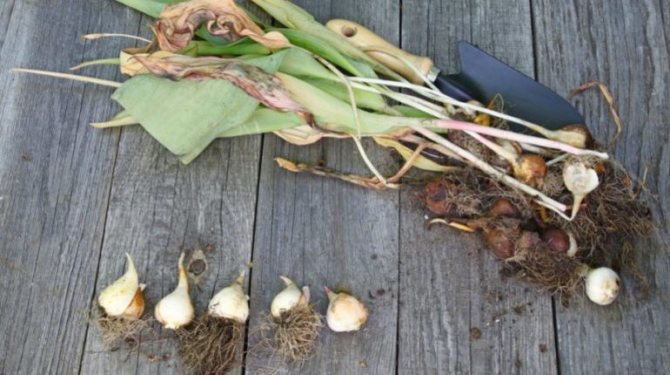

However, the procedure for removing a crop from the land is mandatory only for residents of cold regions, because in the south, with a maximum winter temperature of -5 degrees Celsius, you can protect the plant with spruce branches or a layer of needles. Before that, you need to cut off the foliage and flowering elements.
If the values of winter frosts are more intense and fall below -6 degrees Celsius, digging is a must. And it is important to have time to implement such an action before the arrival of the first night frosts. Otherwise, the root system of the cannes will freeze and undergo putrefactive processes. In middle latitudes, the culture is taken out of the soil in the second decade of September. And in the north they do it at the end of summer. Cleaning before wintering is one of the key requirements for successfully growing cannes.
You may be interested in:
Flowers and plants that love shade in the garden Absolutely every garden has shady places, which, unfortunately, are not considered promising for growing ... Read more ...
Winter storage is carried out in the following ways:
- In wooden structures located in a cellar or basement. In this case, the flowers are stored as grown roots.
- In the refrigerator compartment.
- In a flowerpot on the windowsill.
- As a houseplant.
Advice!
The preparation for the shelter is determined from the method used, but the principles of removing a plant from the ground remain the same.
This action is carried out in dry sunny weather, carefully digging up the tubers with a shovel. It is important to be very careful or damage the fragile root system of the crop.
Storage options
There are different ways to keep cannes until spring. Here is some of them:
- storage of dried rhizomes, folded in wooden containers. Cellars or basements are used for storage;
- in a refrigerator;
- in a pot of earth (at rest);
- on the windowsill, like an indoor flower.
Before storing cannes in winter, they need preliminary preparation. At the same time, it is different for each method of saving, but flowers are dug up according to the same principle.
You should remove roots from the ground in dry weather. To avoid damage, they need to be dug out directly with a lump of soil. Then the soil composition familiar to flowers will remain, and the flowers will not have to get used to another land.
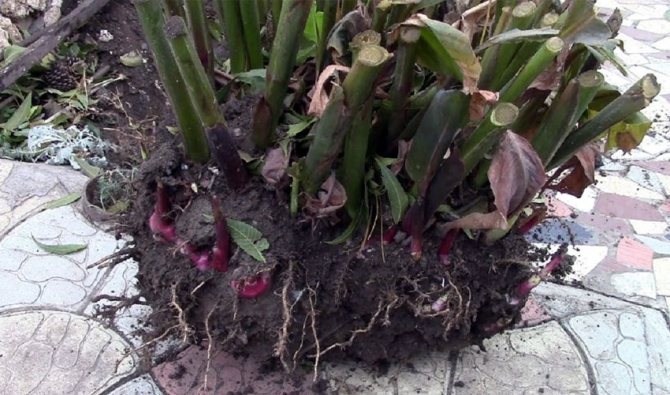

Description of the species
There are more than fifty species of this plant. It grows in India and China and Central America. If you translate the name "canna" from the Greek language, it sounds like "reed". From Latin, as a "pipe". This name is not given by chance. According to legend, an Indian leader burned a world treaty rolled into a tube in a fire. This led to war. On the site of the fire, a beautiful red flower - canna - has grown. The red color seemed to symbolize the color of the blood spilled in the war.
But canna blooms not only with red flowers. Some varieties are orange, yellow, pink. A distinctive feature of the plant is that its leaves can also be of different colors. You can find specimens with leaves of purple, purple, dark green.
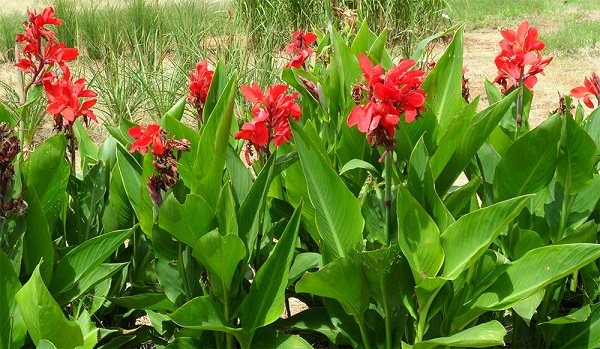

Cannes varieties
Indian Canna (Canna indica)
The progenitor of almost all types of cannes popular today is canna indian.
The cultivated varieties of Indian Cannes, obtained as a result of many years of selection, were called garden canna. Florists divide these hybrids into three groups:
Cannes Crosey
Low-growing species (60-160 cm), the flowers of which resemble gladioli. The leaves, covered with a white bloom, have a dark green or purple-bronze hue, the flower petals are folded back. The first hybrid by the French breeder Crozi was created in 1868, and this garden canna was named Canna Crozi or french cannes
... The best Cannes Crozy varieties:
Livadia
(up to 1 m high, red-crimson inflorescences 25-30 cm long, purple leaves, blooms from July),
America
(120-140 cm tall, cinnabar-red flowers 12 cm in diameter, inflorescence length 30-35 cm, purple leaves, blooms from July),
The president
(up to 1 m tall, bright red flowers in inflorescences about 30 cm long, green leaves, blooms from July), etc.
Orchid cannes
The shape of the flower is reminiscent of Cattleya. These are tall varieties (1-2 m) with large flowers (12.5-17.5 cm), the petals of which have corrugated edges. The leaves are green or purple-green. Popular varieties: Andenken an Pfitzer
(110-140 cm, inflorescences up to 30 cm long consist of bright orange flowers with red strokes, the leaves are brown-purple, blooms from July),
Suevia
(height up to 1m, lemon flowers, inflorescence 12x15 cm, green leaves, blooms at the end of June),
Richard Wallace
(up to 1 m tall, flowers are light yellow with red dots in inflorescences 20-23 cm long, green leaves, blooms from July), etc.
In the photo: Orchid canna
Deciduous (small-flowered) cannes
They grow up to 3 m in height, have very beautiful leaves of green, purple and violet-green colors, but the flowers of these cannes are small, the size does not exceed 6 cm, they are rarely found in culture. The most famous variety of small-flowered canna is Durban:
the flower is yellow-orange, the leaves are striped, pink-bronze-yellow-green - a real decoration of any garden.
In the photo: Indian Canna (Canna indica)
Cannes flowers - features
At first glance, the canna flower looks like a hybrid of a banana with a gladiolus or orchid. The plant has only two drawbacks: in our latitudes it hibernates badly in the open field and does not smell at all. All other characteristics are solid advantages. The main one is that the plant is almost not sick with anything, so growing canna will not cause trouble even for a novice florist. Canna, for all its beauty and decorativeness, is generally unpretentious, drought-resistant, and decorates the garden with flowering from the end of June until the very frosts.
Cannes rhizome branches, expanding in breadth. Flowering stems are erect, thick, high (from 0.6 to 3 m). The leaves are large, powerful, pointed, oblong or elliptical, reaching 25-80 cm in length and 10-30 cm in width.The shape and color of the leaves makes the plant attractive even without flowers, but only when the canna blooms, you will understand that such beauty and harmony. The flowers are sharply asymmetrical, bisexual, 4-8 cm in size, the original color is red, but today, thanks to the work of breeders, varieties of yellow, pink, orange flowers have been bred, there are two-color ones, with a border and even speckled. White cannes are the least common. Flowers are collected in paniculate or racemose inflorescences. The fruit is a three-celled capsule.


